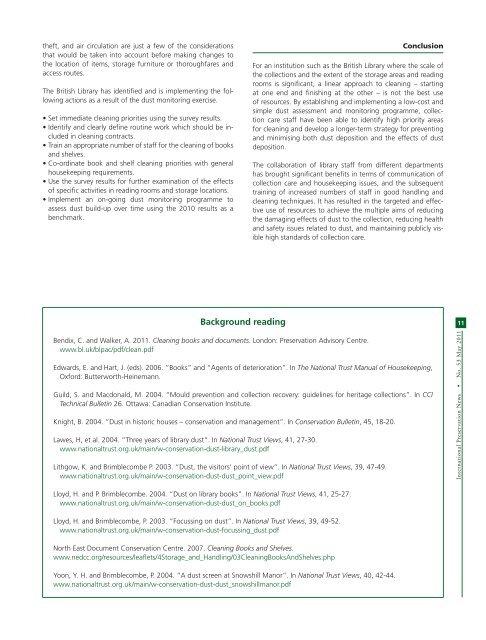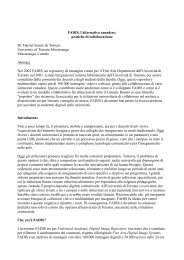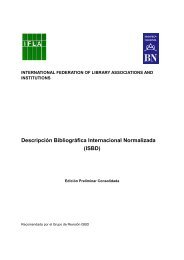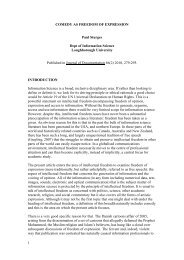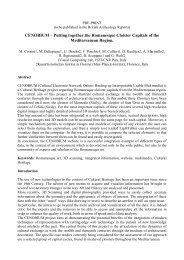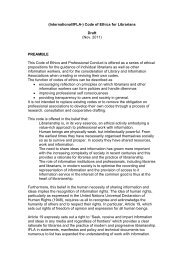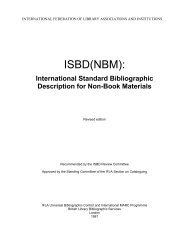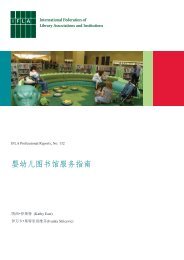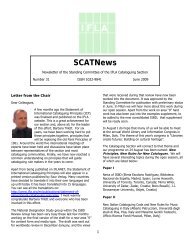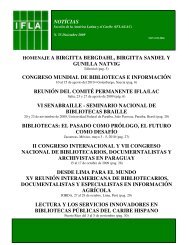Low Cost Dust Monitoring at The British Library - IFLA
Low Cost Dust Monitoring at The British Library - IFLA
Low Cost Dust Monitoring at The British Library - IFLA
You also want an ePaper? Increase the reach of your titles
YUMPU automatically turns print PDFs into web optimized ePapers that Google loves.
theft, and air circul<strong>at</strong>ion are just a few of the consider<strong>at</strong>ions<br />
th<strong>at</strong> would be taken into account before making changes to<br />
the loc<strong>at</strong>ion of items, storage furniture or thoroughfares and<br />
access routes.<br />
<strong>The</strong> <strong>British</strong> <strong>Library</strong> has identifi ed and is implementing the following<br />
actions as a result of the dust monitoring exercise.<br />
Set immedi<strong>at</strong>e cleaning priorities using the survey results.<br />
Identify and clearly defi ne routine work which should be included<br />
in cleaning contracts.<br />
Train an appropri<strong>at</strong>e number of staff for the cleaning of books<br />
and shelves.<br />
Co-ordin<strong>at</strong>e book and shelf cleaning priorities with general<br />
housekeeping requirements.<br />
Use the survey results for further examin<strong>at</strong>ion of the effects<br />
of specifi c activities in reading rooms and storage loc<strong>at</strong>ions.<br />
Implement an on-going dust monitoring programme to<br />
assess dust build-up over time using the 2010 results as a<br />
benchmark.<br />
Background reading<br />
Conclusion<br />
For an institution such as the <strong>British</strong> <strong>Library</strong> where the scale of<br />
the collections and the extent of the storage areas and reading<br />
rooms is signifi cant, a linear approach to cleaning – starting<br />
<strong>at</strong> one end and fi nishing <strong>at</strong> the other – is not the best use<br />
of resources. By establishing and implementing a low-cost and<br />
simple dust assessment and monitoring programme, collection<br />
care staff have been able to identify high priority areas<br />
for cleaning and develop a longer-term str<strong>at</strong>egy for preventing<br />
and minimising both dust deposition and the effects of dust<br />
deposition.<br />
<strong>The</strong> collabor<strong>at</strong>ion of library staff from different departments<br />
has brought signifi cant benefi ts in terms of communic<strong>at</strong>ion of<br />
collection care and housekeeping issues, and the subsequent<br />
training of increased numbers of staff in good handling and<br />
cleaning techniques. It has resulted in the targeted and effective<br />
use of resources to achieve the multiple aims of reducing<br />
the damaging effects of dust to the collection, reducing health<br />
and safety issues rel<strong>at</strong>ed to dust, and maintaining publicly visible<br />
high standards of collection care.<br />
Bendix, C. and Walker, A. 2011. Cleaning books and documents. London: Preserv<strong>at</strong>ion Advisory Centre.<br />
www.bl.uk/blpac/pdf/clean.pdf<br />
Edwards, E. and Hart, J. (eds). 2006. “Books” and “Agents of deterior<strong>at</strong>ion”. In <strong>The</strong> N<strong>at</strong>ional Trust Manual of Housekeeping,<br />
Oxford: Butterworth-Heinemann.<br />
Guild, S. and Macdonald, M. 2004. “Mould prevention and collection recovery: guidelines for heritage collections”. In CCI<br />
Technical Bulletin 26. Ottawa: Canadian Conserv<strong>at</strong>ion Institute.<br />
Knight, B. 2004. “<strong>Dust</strong> in historic houses – conserv<strong>at</strong>ion and management”. In Conserv<strong>at</strong>ion Bulletin, 45, 18-20.<br />
Lawes, H, et al. 2004. “Three years of library dust”. In N<strong>at</strong>ional Trust Views, 41, 27-30.<br />
www.n<strong>at</strong>ionaltrust.org.uk/main/w-conserv<strong>at</strong>ion-dust-library_dust.pdf<br />
Lithgow, K. and Brimblecombe P. 2003. “<strong>Dust</strong>, the visitors’ point of view”. In N<strong>at</strong>ional Trust Views, 39, 47-49.<br />
www.n<strong>at</strong>ionaltrust.org.uk/main/w-conserv<strong>at</strong>ion-dust-dust_point_view.pdf<br />
Lloyd, H. and P. Brimblecombe. 2004. “<strong>Dust</strong> on library books”. In N<strong>at</strong>ional Trust Views, 41, 25-27.<br />
www.n<strong>at</strong>ionaltrust.org.uk/main/w-conserv<strong>at</strong>ion-dust-dust_on_books.pdf<br />
Lloyd, H. and Brimblecombe, P. 2003. “Focussing on dust”. In N<strong>at</strong>ional Trust Views, 39, 49-52.<br />
www.n<strong>at</strong>ionaltrust.org.uk/main/w-conserv<strong>at</strong>ion-dust-focussing_dust.pdf<br />
North East Document Conserv<strong>at</strong>ion Centre. 2007. Cleaning Books and Shelves.<br />
www.nedcc.org/resources/leafl ets/4Storage_and_Handling/03CleaningBooksAndShelves.php<br />
Yoon, Y. H. and Brimblecombe, P. 2004. “A dust screen <strong>at</strong> Snowshill Manor”. In N<strong>at</strong>ional Trust Views, 40, 42-44.<br />
www.n<strong>at</strong>ionaltrust.org.uk/main/w-conserv<strong>at</strong>ion-dust-dust_snowshillmanor.pdf<br />
11<br />
Intern<strong>at</strong>ional Preserv<strong>at</strong>ion News No. 53 May 2011


